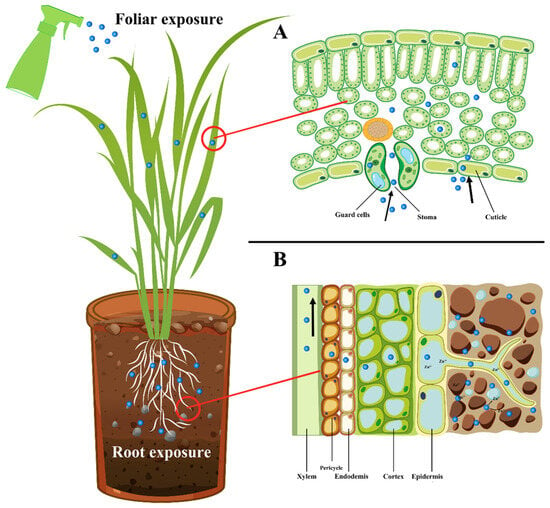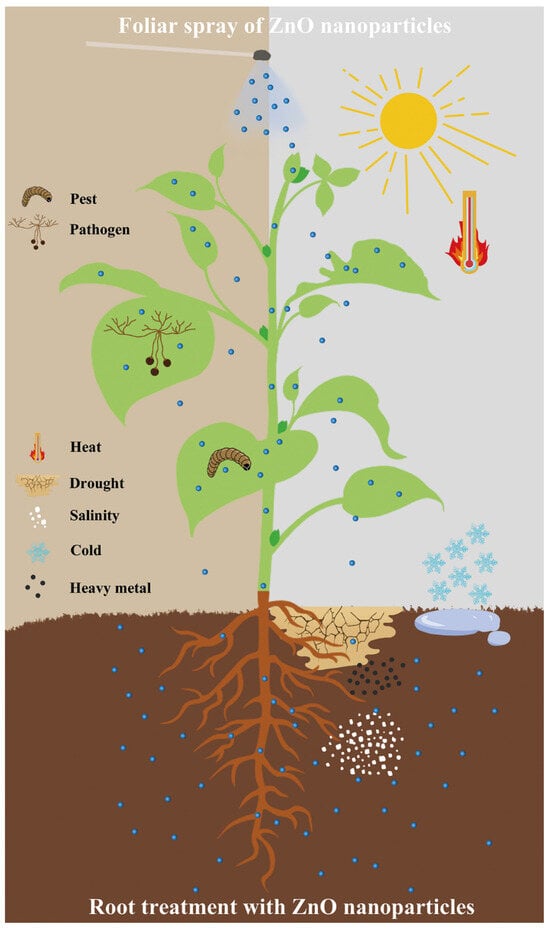Zinc oxide nanoparticles (ZnO nanoparticles) have gained substantial attention from researchers worldwide for their capacity to alleviate the detrimental impacts of both biotic and abiotic stress on plants, concurrently reducing dependence on environmentally harmful chemicals.
- zinc oxide
- nanoparticles
- agriculture
- plants
- biotic stress
- abiotic stress
1. Introduction
2. Preparation of ZnO Nanoparticles
The methods employed for synthesizing ZnO nanoparticles encompass physical, chemical, and biological approaches, as depicted in Figure 1. During the synthesis process, ZnO nanoparticles may undergo contamination, such as the introduction of iron ions, resulting in a notable change in the solubility of ZnO nanoparticles. Impurities in ZnO nanoparticles can arise from factors like the purity of reactants or the type of reaction vessel utilized in the synthesis process. Utilizing diverse synthesis methods and reactants enables the production of nano zinc oxide with varying impacts on plants, even while maintaining consistent particle sizes and shapes [52][67].
3. Absorption and Transfer of ZnO Nanoparticles in the Plant
3. Absorption and Transfer of ZnO Nanoparticles in the Plant

4. Impact of ZnO Nanoparticles against Biotic and Abiotic Stress

4.1. Impact of ZnO Nanoparticles against Biotic Stress
4.1.1. Pests
4.1.2. Plant Pathogens
4.2. Impact of ZnO Nanoparticles against Abiotic Stress
4.2.1. Drought Stress
Drought, a prevalent abiotic stress, can considerably diminish crop yields by inducing prolonged water scarcity. Water, functioning as a medium for plant survival and nutrient transportation, is pivotal for the robust growth of crops. Drought stress influences diverse physiological and biochemical processes in plants, thus jeopardizing their typical survival capabilities. The quest for innovative approaches to tackle drought stress has become significantly crucial. Previous research has reported that ZnO nanoparticles can enhance drought-stress tolerance in plants, mitigating the negative impacts of drought on crop yield and biomass accumulation. Sun et al. investigated the effect of ZnO nanoparticles on drought tolerance in plants and revealed their ability to stimulate the synthesis of the endogenous hormone melatonin. Alterations in the activity of antioxidant enzymes were also noted, including malondialdehyde, catalase, and ascorbate peroxidase, thus activating the plant’s internal antioxidant system [92][93][173,174].4.2.2. Heat Stress
In recent years, the increasing levels of carbon dioxide emissions have intensified the greenhouse effect, resulting in severe high-temperature weather conditions. When temperatures exceed the optimal range for specific time periods or when plants are exposed to prolonged high-intensity light, they undergo heat stress, which adversely affects the normal growth and yield of crops. The application of ZnO nanoparticles has been observed to effectively enhance the heat stress tolerance in a few plant species (alfalfa, mungbean, chickpea, and wheat). A sufficient supply of zinc under heat stress can regulate the PSII efficiency of plants, improve water relations, increase free proline in leaves, enhance antioxidant enzyme activities (SOD, MDA, H2O2, and APX), and elevate the concentration of zinc ions in leaves. This can help mitigate the detrimental impacts of heat stress on plants, leading to improved plant growth and photosynthesis [94][95][179,180].4.2.3. Salinity Stress
Salt stress, as one of the most prevalent abiotic stresses globally, is exacerbated by various factors such as climate change, irrigation water contamination, and improper fertilizer application, resulting in soil salinization and subsequent crop yield reduction. Soil salinization typically disrupts plant osmotic balance, induces ion toxicity, and diminishes water availability, leading to disturbances in plant physiological and biochemical processes and causing structural damage to plant morphology. ZnO nanoparticles can enhance plant salt tolerance by improving membrane integrity, scavenging reactive oxygen species generated by stress, regulating cell division, nutrient and water transport, and modulating levels of carbohydrates, amino acids, protein metabolism, photosynthetic pigments, and osmoregulators. Extensive research has reported the potential of ZnO nanoparticles in mitigating the adverse impacts of salinity stress on various crops, such as safflower, wheat, tomato, pea, rice, rapeseed, and so on [96][97][98][99][100][101][102][103][183,184,185,186,187,188,189,190].4.2.4. Cold Stress
Cold stress hinders the growth and reduces the yield of crops by affecting their physiological, biochemical, molecular, and metabolic processes [104][105][106][193,194,195]. Some studies have reported that ZnO nanoparticles can alleviate the harm caused by cold stress in various plants [107][108][109][58,196,197]. At the physiological level, foliar application of ZnO nanoparticles can alleviate the inhibitory effect of low-temperature stress on the growth of rice seedlings (including plant height, root length, and dry biomass). At the physiological level, ZnO nanoparticles can restore rice chlorophyll accumulation under cold stress, increase the activity of antioxidant enzymes (SOD, POD, CAT), and reduce intracellular H2O2, MDA, and proline content. At the molecular level, foliar application of ZnO nanoparticles can induce the expression of antioxidant systems (OsCu/ZnSOD1, OsCu/ZnSOD2, OsCu/ZnSOD3, OsPRX11, OsPRX65, OsPRX89, OsCATA, and OsCATB) and cold-responsive transcription factors (such as OsbZIP52, OsMYB4, OsMYB30, OsNAC5, OsWRKY76, and OsWRKY94) in young rice leaves under cold treatment. This leads to the restoration of the expression of all the mentioned genes to the control level after cold stress, effectively mitigating the harm of cold stress to plants [109][197].4.2.5. Heavy Metal Stress
The contamination of terrestrial soil by heavy metals (arsenic (As), Pb (plumbum), Cd (cadmium), mercury (Hg), and chromium (Cr)) has become a significant global environmental issue, adversely affecting ecological integrity, soil quality, and agricultural productivity [110][111][112][198,199,200]. The resulting food security concerns pose a substantial risk to ecosystems and human health. Consequently, the remediation or immobilization of toxic heavy metals in contaminated farmlands has become an urgent and critical issue [113][114][201,202]. Li et al. reported that the treatment of rice seeds with ZnO nanoparticles affects the physiological, biochemical, and molecular characteristics of plants under cadmium stress. At the physiological level, ZnO nanoparticles can increase plant fresh weight and root crown length. At the biochemical level, ZnO nanoparticles can enhance the activity of antioxidant enzymes (SOD, POD) in rice, as well as the content of metallothioneins (ROS scavengers) and chlorophyll (chlorophyll a, chlorophyll b, a + b, and carotenoids). At the metabolic level, ZnO nanoparticles primarily alleviate the harm of cadmium to rice by affecting the metabolism of amino acids (alanine, aspartate, and glutamate), taurine, subtaurine, and phenylpropanoid biosynthesis. Additionally, the application of zinc oxide can effectively increase the activity of α and β-amylase (in seeds) and total amylase (in seedlings), which may be beneficial for seed germination [115][203]. In mung bean plants, ZnO nanoparticles reduce the harm of cadmium to plants by regulating cellular homeostasis. ZnO nanoparticles enhance the activity of ROS scavenging enzymes (such as CAT, APX, GR, glutathione peroxidase (GPX), and guaiacol peroxidase (GPOX)) to reduce plant toxicity caused by cadmium stress. ZnO nanoparticles also regulate redox enzymes (such as NADPH-dependent thioredoxin reductase (NTR), ferredoxin (Fd), ferredoxin-NADP reductase (FNR), and thioredoxin (Trx)), effectively improving plant growth under cadmium stress [115][203]. ZnO nanoparticles exhibit a high affinity for heavy metals, enabling them to bind and immobilize these toxic substances in the soil. This capability effectively mitigates the adverse effects of heavy metal pollution on plant growth and overall soil quality. At the molecular level, the expression levels of OsNRAMP1, OsNRAMP4, and OsNRAMP5 genes involved in cadmium transport in rice under cadmium stress decreased significantly with treatment using zinc oxide nanomaterials, while the expression of the OsZIP1 gene related to zinc transport exhibited upregulation. This suggests that zinc oxide nanomaterials can alleviate cadmium toxicity in rice by enhancing the expression levels of resistance-related genes [116][204].5. Conclusions
At the physiological level, ZnO nanoparticles can enhance the agronomic traits of plants under stressful conditions, promoting increased plant growth and biomass. At the biochemical level, ZnO nanoparticles exhibit the ability to boost the activity of plant antioxidant enzymes, scavenge ROS generated under stress, regulate osmotic balance, and maintain cellular homeostasis, thereby alleviating the impact of both biotic and abiotic stress on plants. On the molecular level, ZnO nanoparticles can influence plant hormone signaling pathways, modulate stress-responsive genes, and enhance plant stress tolerance. Hence, the utilization of ZnO nanoparticles is anticipated to offer a novel, environmentally friendly, and cost-effective method to enhance agricultural productivity while mitigating the impact of various stressors on plants.
